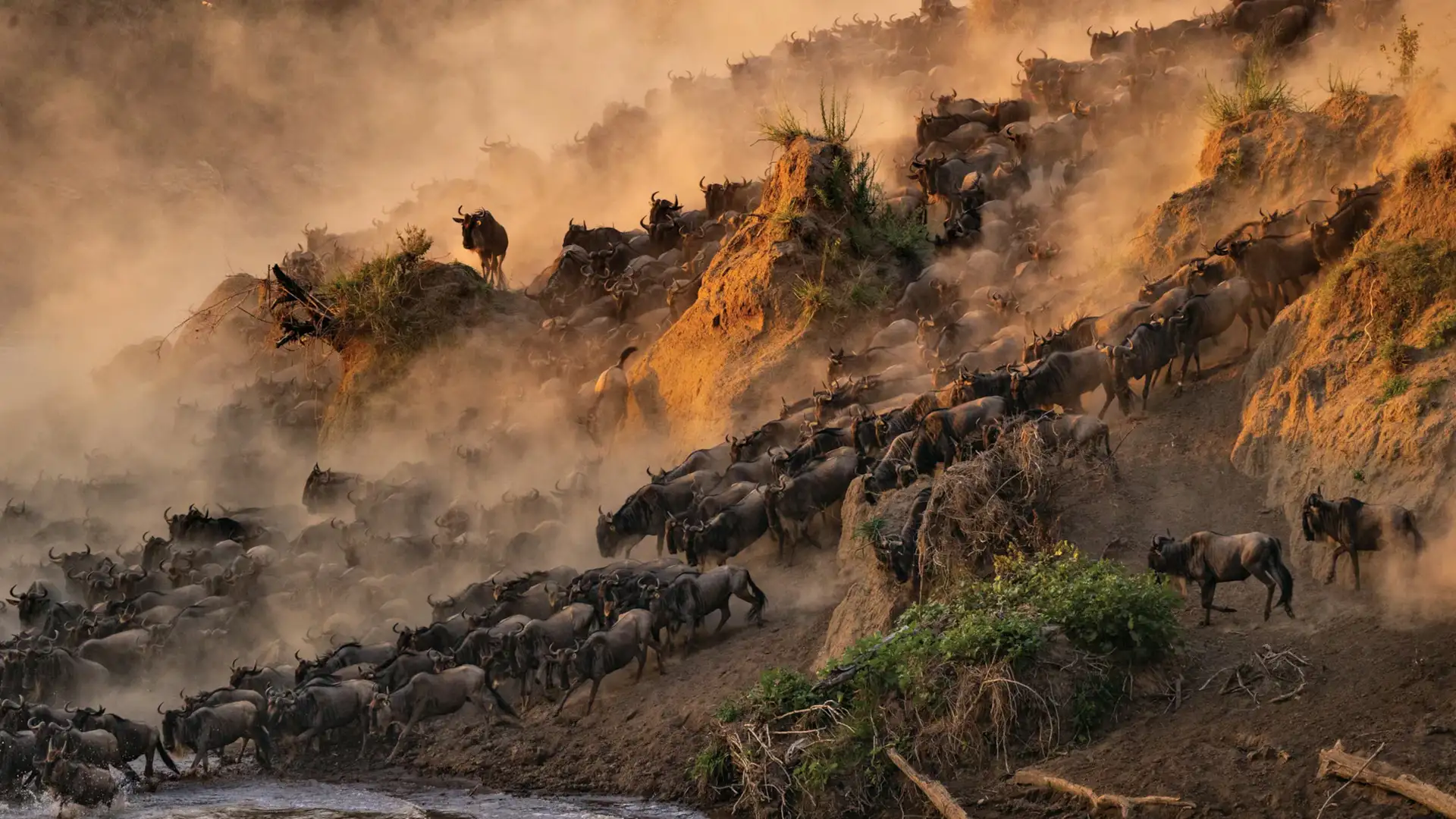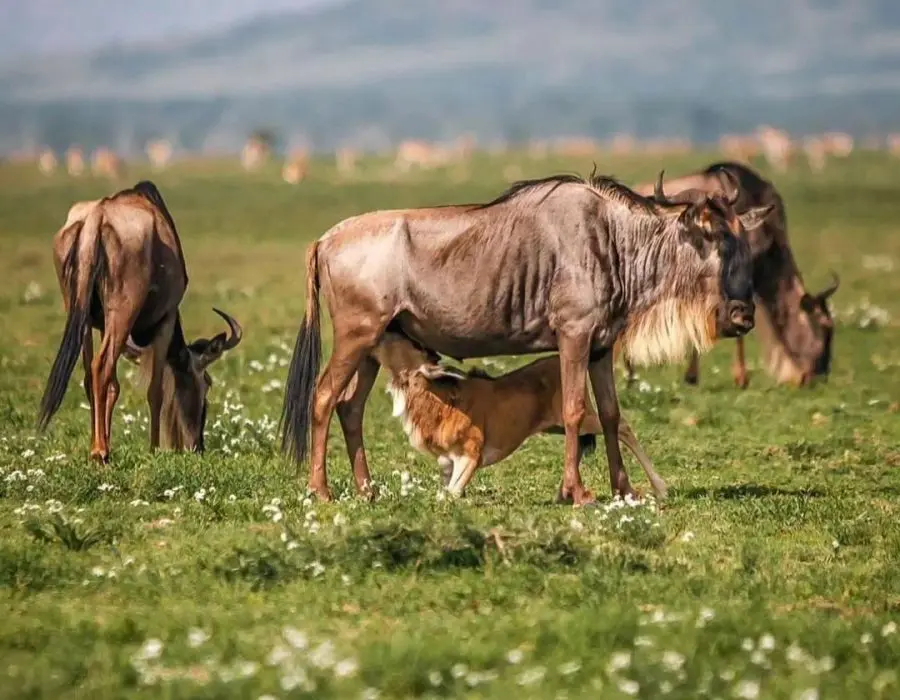The Great Wildebeest Migration is one of the most breathtaking natural phenomena on Earth. Each year, over 1.5 million wildebeest, accompanied by zebras, gazelles, and other herbivores, embark on a perilous journey across the Serengeti-Mara ecosystem in search of fresh grazing lands. This never-ending cycle of survival unfolds across Tanzania’s Serengeti National Park and Kenya’s Masai Mara Reserve, offering one of the most thrilling safari experiences in the world.
Whether you want to witness the calving season in Ndutu, the dangerous river crossings of the Mara River, or the endless herds roaming the plains of the Serengeti, the Wildebeest Migration promises unforgettable encounters with Africa’s raw and untamed beauty.

🌿 Highlights:
🔹 Best for: Visitors who want to see newborns and intense predator-prey interactions.
🌾 Highlights:
🔹 Best for: Travelers seeking fewer crowds and stunning landscapes.
🌊 Highlights:
🔹 Best for: Those who want to witness the most thrilling and dramatic moments of the migration.
🍃 Highlights:
🔹 Best for: Travelers who prefer quieter safari experiences with great wildlife sightings.


Soar above the Serengeti at sunrise and witness the migration from a breathtaking aerial perspective.

A private or guided game drive is the best way to track the movement of the herds and witness predator action firsthand.

Luxury mobile tented camps move with the herds, ensuring you’re always in the right place at the right time.

Explore Serengeti’s wilderness with expert guides and get a more intimate understanding of the ecosystem.
🏕️ Southern Serengeti (Jan-Mar): Ndutu Safari Lodge, Serengeti Migration Camp
🏕️ Central Serengeti (Apr-June): Dunia Camp, Kati Kati Tented Camp
🏕️ Western Serengeti (June-July): Grumeti Serengeti River Lodge, Mbalageti Safari Camp
🏕️ Northern Serengeti (July-Oct): Sayari Camp, Mara River Tented Camp
🏕️ Masai Mara (Aug-Oct): Angama Mara, Sanctuary Olonana
📅 Ready to Witness the Migration? Contact us today and start planning your once-in-a-lifetime Wildebeest Migration safari!

The best time depends on what you want to see:
The best time is during the dry season (June to October), but private safaris are available year-round, each season offering unique experiences.
The Great Wildebeest Migration is one of the most breathtaking natural phenomena on Earth. Each year, over 1.5 million wildebeest, accompanied by zebras, gazelles, and other herbivores, embark on a perilous journey across the Serengeti-Mara ecosystem in search of fresh grazing lands. This never-ending cycle of survival unfolds across Tanzania’s Serengeti National Park and Kenya’s Masai Mara Reserve, offering one of the most thrilling safari experiences in the world.
Whether you want to witness the calving season in Ndutu, the dangerous river crossings of the Mara River, or the endless herds roaming the plains of the Serengeti, the Wildebeest Migration promises unforgettable encounters with Africa’s raw and untamed beauty.

🌿 Highlights:
🔹 Best for: Visitors who want to see newborns and intense predator-prey interactions.
🌾 Highlights:
🔹 Best for: Travelers seeking fewer crowds and stunning landscapes.
🌊 Highlights:
🔹 Best for: Those who want to witness the most thrilling and dramatic moments of the migration.
🍃 Highlights:
🔹 Best for: Travelers who prefer quieter safari experiences with great wildlife sightings.


Soar above the Serengeti at sunrise and witness the migration from a breathtaking aerial perspective.

A private or guided game drive is the best way to track the movement of the herds and witness predator action firsthand.

Luxury mobile tented camps move with the herds, ensuring you’re always in the right place at the right time.

Explore Serengeti’s wilderness with expert guides and get a more intimate understanding of the ecosystem.
🏕️ Southern Serengeti (Jan-Mar): Ndutu Safari Lodge, Serengeti Migration Camp
🏕️ Central Serengeti (Apr-June): Dunia Camp, Kati Kati Tented Camp
🏕️ Western Serengeti (June-July): Grumeti Serengeti River Lodge, Mbalageti Safari Camp
🏕️ Northern Serengeti (July-Oct): Sayari Camp, Mara River Tented Camp
🏕️ Masai Mara (Aug-Oct): Angama Mara, Sanctuary Olonana
📅 Ready to Witness the Migration? Contact us today and start planning your once-in-a-lifetime Wildebeest Migration safari!

The best time depends on what you want to see:
The best time is during the dry season (June to October), but private safaris are available year-round, each season offering unique experiences.
Let’s connect on WhatsApp! Tap the button below to start chatting 💬👇. Prefer a different way to reach us? Explore the other messaging options we’ve got for you 🐾
et in touch with us on Facebook! Click the button below to start a chat, and we’ll get back to you in no time.
Connect with us on Telegram! Hit the button below to start chatting, and we’ll do our best to respond quickly.
Give us a call at Call us at +255 760-410-765 —we’re here to assist you!